News and Analysis on scarce coins, markets, and the collecting community #82
A Weekly CoinWeek Column by Greg Reynolds
Last week, the firm of Stack’s-Bowers Galleries (SBG) conducted a very large auction at the Baltimore Coin & Collectible Expo. Before this event, I wrote a report regarding the Teich Family Collection of Proof coins and I discussed Southern Gold, two offerings for which this auction is most likely to be remembered. (As always, clickable links are in blue.) This week, I am focusing on business strike quarters in this same auction.
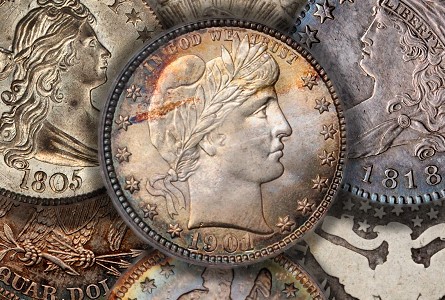 I thought about writing a review that emphasizes the most expensive coins in the auction, or the most expensive coins in various categories. Indeed, I have written a large number of such auction reviews. A discussion centered on the most expensive coins, however, would not provide an accurate or a fair image of the offerings in a typical coin auction. Of course, it makes sense to mention expensive coins exclusively in a review of an SBG ‘Rarities Night’ or of a Heritage ‘Platinum Night’ event. This SBG Baltimore auction, though, contained thousands of coins, arranged by denomination, type and year. Only the Teich Family Collection was segregated.
I thought about writing a review that emphasizes the most expensive coins in the auction, or the most expensive coins in various categories. Indeed, I have written a large number of such auction reviews. A discussion centered on the most expensive coins, however, would not provide an accurate or a fair image of the offerings in a typical coin auction. Of course, it makes sense to mention expensive coins exclusively in a review of an SBG ‘Rarities Night’ or of a Heritage ‘Platinum Night’ event. This SBG Baltimore auction, though, contained thousands of coins, arranged by denomination, type and year. Only the Teich Family Collection was segregated.
Over the years, I have been told by many collectors that sometimes they do not wish to read a list, or an analysis, of the most expensive coins in an auction. Most collectors wish to read about a variety of coins, uncirculated and circulated coins, Proofs and business strikes, expensive and inexpensive coins, rare dates and type coins, and even about ungradable coins. If I wrote about the twenty-five most expensive coins in this auction, it would then be difficult to convey here points about the depth of the offerings or references to successful sales of moderately priced coins.
So, in order to mix discussions herein of rarities, scarce coins, and relatively common coins, including circulated and uncirculated coins, I have chosen business strike quarters as the current topic. One of the reasons for this choice is that this auction contained several representatives of key date business strike quarters in circulated grades, which are of interest to many thousands of collectors. Furthermore, I discuss more than a few gem quality quarters. Also, this auction had more impressive offerings of quarters dating from 1853 to 1916 than of quarters from other time periods. So, my coverage is weighted accordingly.
I. Draped Bust Quarters
There were two 1796 quarters in this auction. The first is PCGS graded ‘Extremely Fine-40.’ It is not thrilling, though it is probably acceptable. Jim McGuigan remarks that it is ‘moderately cleaned and grades VF-30,” in his view. It sold for $46,000, a solid retail price, and a very strong auction result. I thought that it would sell for less than $40,000.
The second 1796 quarter may be suitable for the collector who is unable or unwilling to spend even $10,000 on a coin of this one-year type. This quarter is not gradable, though it has the details of a Poor to Fair grade coin. Unfortunately, it has been holed and notably plugged. It sold for $2588 and it would be hard to buy another 1796 quarter for less.
In the online prices realized, results are ’rounded up’ to whole dollar amounts. So, I cite the whole dollar amounts herein. A price that seems to me to be $2587.50 is thus ’rounded up’ to $2588. Moreover, preliminary reports may contain errors. For an official copy of the prices realized, collectors should address SBG directly.
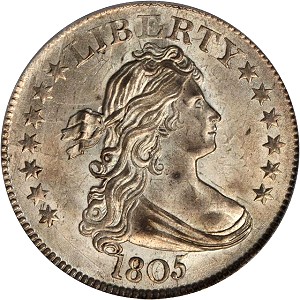 The 1804 quarter in this auction brought an exceptionally high price. It is not certified by the PCGS or the NGC. In my view, it is not gradable. Jim McGuigan agrees. Another service did, however, grade it as “Very Fine-25.” I am surprised that it brought $9775, a retail price for a nice, Fine-12 grade 1804 quarter. I would have expected this coin to sell for about $5000.
The 1804 quarter in this auction brought an exceptionally high price. It is not certified by the PCGS or the NGC. In my view, it is not gradable. Jim McGuigan agrees. Another service did, however, grade it as “Very Fine-25.” I am surprised that it brought $9775, a retail price for a nice, Fine-12 grade 1804 quarter. I would have expected this coin to sell for about $5000.
While the 1804 quarter is rare and the 1805 is not rare, just very scarce, 1805 quarters are extremely rare in uncirculated condition. The 1805 in this auction is PCGS graded “MS-63.” The consignor, “MHS,” purchased it from Jim McGuigan in 2006.
At a glance, this 1805 looks like it might grade ‘MS-64.’ Upon closer inspection, however, I found numerous scratches among the clash marks, plus some light friction. I am not sure that it even should grade “MS-63.” McGuigan suggests that he never graded it as “MS-63.”
The price realized, $18,975, is very strong, in my view. McGuigan disagrees. He does not find this result to be particularly high or strong. The $18,975 result is “a fair price for a collector or [even] a dealer, nice coin. This [amount] is just a little beyond what I wanted to pay,” Jim comments. For more than seventeen years, McGuigan has been a recognized specialist in pre-1840 U.S. coins of all metals.
The price realized for the 1806/5 overdate is even stronger. It is NGC graded “MS-64” and is pedigreed to Louis Eliasberg who assembled the all-time best collection of U.S. coins.
Though it seems that some misguided individual dipped it (in an acidic solution) since the pertinent Eliasberg sale in April 1997, I am nearly certain that it is, in fact, the Eliasberg 1806/5. In 1997, before it was dipped, Charlie Browne graded this coin as “MS-64.” Since being dipped, ordinary scratches and U.S. Mint caused imperfections are now far more noticeable. In my view, it grades less than 64 now. Would the PCGS grade it as “MS-64”? Would the CAC approve it?
I am astonished that this 1806/5 quarter went for $60,375. This is certainly one of the strongest results in the whole auction. McGuigan points out that “the pedigree adds something to it.” If $12,000 is imputed to the Eliasberg pedigree, however, $48,000 would still be a strong price for this coin.
II. Capped Bust Quarters
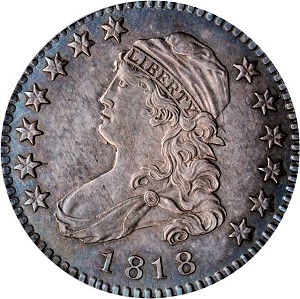 An 1818 Capped Bust Quarter that is PCGS graded “MS-63” sold for $4830. While this seems to be a weak price, it may be true that the seemingly ‘weak price’ can be explained by the fact that this is a ‘low end’ coin for a certified “MS-63” large size Capped Bust Quarter. It does, though, exhibit nice gray-blue natural toning.
An 1818 Capped Bust Quarter that is PCGS graded “MS-63” sold for $4830. While this seems to be a weak price, it may be true that the seemingly ‘weak price’ can be explained by the fact that this is a ‘low end’ coin for a certified “MS-63” large size Capped Bust Quarter. It does, though, exhibit nice gray-blue natural toning.
An “1824/2” quarter is a rare coin, in all grades. There are no ‘perfect date’ 1824 quarters, meaning there are none with just sound, fully developed numerals. Traditionally, all 1824 quarters are referred to as 1824/2 overdates, though the so called ‘overdate’ feature is not readily apparent.
The one in this auction is PCGS graded ‘Very Fine-35’ and sold for $4313, a strong price. It has natural brownish-russet toning and is pleasing for a very fine grade Capped Bust Quarter of the first type, ‘large size.’
Although I just glanced at it briefly, an 1834 Capped Bust Quarter in this auction seems very appealing. Surely, this 1834 is suitable for a non-rich collector, to be placed in a date set or as the ‘small size’ Capped Bust Quarter representative in a type set. It is PCGS graded ‘Extremely Fine-45’ and sold for $489, a moderately strong price. It is naturally toned and is very attractive for its grade.
III. Liberty Seated Quarters
The first type of Liberty Seated Quarters is referred to as having ‘No Drapery.’ These were minted from 1838 to 1840. One in this sale is an 1838 that is PCGS graded “MS-64.” It garnered $10,350, a very strong price and not a good value. There is nothing special about this specific coin.
All 1842 quarters are rare. The NGC graded “AU-55” representative in this auction is noteworthy. While I would grade it as AU-53, it is a nice coin and its certified 55 grade is not unreasonable. It went for $834, a moderate to strong price.
Except for the 1842 and 1842-O ‘Small Date’ issues, the 1849-O is the key date of the No Drapery, No Motto type (or subtype) of Liberty Seated Quarters. In last week’s column, I mentioned the one in this auction, which is PCGS graded Very Fine-30. It sold for $3738, a very strong price, though ‘worth it’!
Quarters with arrows on the obverse (front of the coin) and rays on the reverse (back of the coin) were minted in just one year, 1853, hence these constitute a one-year only design type (or subtype). There were two in this auction. The first, which is PCGS graded “MS-64,” sold for $4025, a moderate to strong price ‘for the holder.’
The second 1853 is PCGS graded “MS-62” and brought $1265, a strong price. The values listed in accepted price guides for this issue in ‘MS-62’ grade are a little low, in my view.
The toning on this 1853 quarter is natural and is really neat. Despite some not unexpected light friction and one notable medium gash on the reverse, it is appealing overall. Moreover, this coin scores very high in the category of originality. While I understand how the assigned 62 grade could be fairly challenged, this coin is very pleasing to view. I like it and I accept the 62 grade.
The business strike 1857 quarter in this auction is from the Peter Stefan collection. It is PCGS graded MS-66. It has been ‘off the market’ for more than a half century and is thus extremely fresh. According to the SBG catalogue, Stefan died in 1956. Further, it is one of the most attractive coins in the whole auction. Indeed, it is extremely attractive.
The terrific toning is even and definitely natural. Various shades of green are especially appealing. On Miss Liberty, there is a nice blend of russet and tan colors, which contrast nicely with the blue toning in the left (her right) inner field along and with green outer fields.
The toning on the reverse is even better. The eagle is mostly a mellow russet-red color with an orange-russet shield. Further, the eagle is surrounded by blue tints. The outer design elements and fields on the reverse are various colors. This coin has to be seen to be appreciated.
It is possible that the Peter Stefan 1857 failed, or would fail, to receive a CAC sticker because of contact marks between Miss Liberty’s upper arm and the sixth star and in between her head and the cap on the pole. If these marks never occurred, however, this coin would merit a 67 grade. In my view, the overall grade still averages out somewhere in the middle of the 66 range. The auction result of $4744 is not strong. Perhaps the leading bidders are more bothered than I was, by the contact marks in the obverse inner fields.
The 1858-S quarter issue is a rare date. Indeed, it is probably rare in all grades, including the ungradable. In this auction, there was an 1858-S that the PCGS determined to be “not gradable,” due to problematic cleaning. “Cleaned long ago,” says the SBG cataloguer, “and now nicely recovering,” It does have the details of a VF-30 to EF-40 grade coin. In my view, this coin has serious problems, more so than could be attributed to a severe cleaning.
While I do not believe that this 1858-S should ever receive a numerical grade, it has naturally retoned and is attractive for an ungradable coin. It would have been a good value had it sold for $400 to $500. It brought $2013, an exceptionally strong price. I hope that a dealer will not ‘crack it out’ and represent it as a problem-free coin. Before collectors buy rare coins that are not certified, they should very closely inspect them or arrange for experts to do so.
It is also true that the 1858-S is often overshadowed by more famous Liberty Seated Quarters, especially by the Carson City issues of the early 1870s. The 1858-S is rarer than most collectors and dealers realize.
The 1859-S is rare, too, and is a key date. The 1859-S quarter in this auction is PCGS graded “AU-50” Its failure to sell is a reflection of the negative characteristics of this specific coin. The reverse has issues. The minimum required commitment of $23,000 was not sensible.
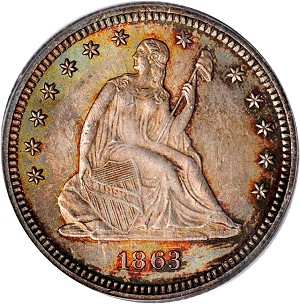 The business strike 1863 in this auction is PCGS graded “MS-64” and has a sticker of approval from the CAC. It has really neat natural toning, especially including pleasing shades of russet and green about the obverse design elements, with patches of orange-russet and yellow in the fields. There is much russet on the reverse that is nicely complemented by blue outer fields. Furthermore, Miss Liberty on the obverse and the eagle on the reverse have toned a mellow tan, with underlying mint frost. Overall, this coin has a very balanced look and is more than very attractive. Some scattered contact marks probably kept it from being awarded a higher grade. I am not surprised that this coin brought an extremely strong price, $2588.
The business strike 1863 in this auction is PCGS graded “MS-64” and has a sticker of approval from the CAC. It has really neat natural toning, especially including pleasing shades of russet and green about the obverse design elements, with patches of orange-russet and yellow in the fields. There is much russet on the reverse that is nicely complemented by blue outer fields. Furthermore, Miss Liberty on the obverse and the eagle on the reverse have toned a mellow tan, with underlying mint frost. Overall, this coin has a very balanced look and is more than very attractive. Some scattered contact marks probably kept it from being awarded a higher grade. I am not surprised that this coin brought an extremely strong price, $2588.
The 1874-S business strike in this auction is a significant type coin. Liberty Seated Quarters, with motto, had arrows on the obverse for only two years, 1873 and 1874. This 1874-S quarter is PCGS graded MS-65 and is CAC approved. It was lightly to moderately dipped not that long ago and has since naturally retoned in a nice manner. It is considerably lustrous. The $3450 result is a strong to very strong price.
Philadelphia Mint business strike quarters from the 1880s tend to be very scarce. A circulated 1886 in this auction appeals to collectors who are assembling sets ‘by date.’ It is PCGS graded ‘Very Fine-25.’ Despite a few short gashes and some hairlines, I like this coin. It has really neat natural toning and is attractive overall. Perhaps at least two bidders are also enthusiastic about it. It sold for $978, an extremely strong price.
Though 1887 Liberty Seated Quarters are very scarce overall, like for some other dates from the 1880s, there are a curiously substantial number of gem quality coins extant. Someone or some bank may have saved rolls.
The business strike 1887 quarter in this auction is impressive. It is PCGS graded MS-66 and has a CAC sticker. This 1887 has wonderful natural toning and underlying original luster. When tilted under a light, it really comes alive. It is more than very attractive overall. It merits a ’66+’ grade, in my view. The price realized, $2,990, is strong, though less than I expected it to bring.
IV. Barber Quarters
This auction contained a noteworthy assortment of Barber Quarters. Circulated key dates and gem quality better dates were features.
The three keys to the series of Barber Quarters were all minted in San Francisco, the 1896-S, the 1901-S and the 1913-S. For the Barber Quarter collector who is unable or just unwilling to spend thousands of dollars on one coin, there were two 1896-S quarters in this auction in Good condition.
“From the Peter J. Stefan Collection,” there was an NGC graded ‘Good-04’ 1896-S, with a CAC sticker. While it is great that this coin has full rims, it is otherwise mediocre, with plenty of issues. It brought $748, a fair price, commensurate with its quality or lack thereof.
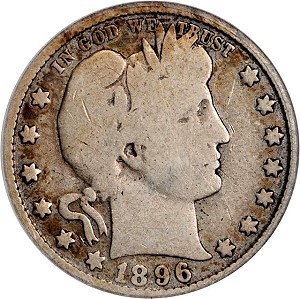 The other 1896-S is PCGS graded ‘Good-06’ and also has a CAC sticker. Though the rims are not as sharp on this 1896-S, it is much better than the just mentioned coin. Indeed, in my view, there is a considerable difference in their respective quality.
The other 1896-S is PCGS graded ‘Good-06’ and also has a CAC sticker. Though the rims are not as sharp on this 1896-S, it is much better than the just mentioned coin. Indeed, in my view, there is a considerable difference in their respective quality.
The ‘Good-06’ 1896-S does not have any significant problems and has a pleasant overall ‘look.’ Though lightly cleaned long ago, it is naturally retoning a mild gray, with brownish-russet tones about the outer design elements. The reverse is mostly a light, mellow gray color. It is more than very attractive for its grade and is appealing overall. The $863 price is not strong and is a good deal.
I like the 1900 Barber Quarter in this sale. It is NGC graded “MS-66” and is in an old NGC holder. It exhibits mellow toning, mostly shades of russet, especially brown-russet, plus much blue. There is subtle underlying original luster. A tan-brown-russet shade predominates on the reverse. There are hardly any contact marks. This is a very attractive coin.
This 1900 quarter sold for $1610, which is not a strong price. I hypothesize that the weak result is mostly because it is stale. Fresh coins have been ‘off the market’ for more than five years. This exact same 1900 quarter was just auctioned by Heritage in Chicago.
In August, this 1900 quarter was auctioned as part of a significant collector-consignment. It may be true that a dealer failed to privately sell it for a profit after then acquiring it for $1725. While there is certainly more to the story of this coin than I know, it usually does not make sense to buy a coin at a major auction in August and then consign it to another auction in November of the same year. Nevertheless, the sale of this 1900 quarter for $1610 was a good deal for the buyer at the SBG auction.
A 1901 is one of the most important business strike Barber Quarters in this auction. It is PCGS graded MS-66 and is CAC approved. It is almost certainly one of the half-dozen finest known 1901 quarters. It is more than very attractive. Though moderately dipped long ago, it has naturally retoned nicely, with streaks of orange-russet on the obverse. The toning on the reverse is very pleasing, with blue, orange-russet, green, and even some red, along with a silver central area. Indeed, this coin looks better in actuality than it does in catalogue images.
This 1901 sold for $4025, a very strong to extremely strong price, a little too much, in my opinion. This exact same coin was auctioned by Heritage in June 2010 for $2760. While it did not then have a CAC sticker, it is hard to imagine CAC approval adding more than 45% to the value of this particular coin. To most coin experts, it is obviously an excellent coin. It is true, though, that MS-66 grade 1901 quarters are probably under-rated in general, from a logical perspective.
The 1901-S is the leading key in the Barber Quarter series. There was a PCGS graded “Good-06” 1901-S in this auction. It is not a stellar representative of a Barber Quarter in ‘Good’ condition. It is just barely gradable. It sold for $5290, an amount commensurate with its quality. A more pleasant ‘Good-06’ grade 1901-S would have sold for more than $6000, maybe much more.
Although 1905 Barber Quarters are not scarce and I just glanced at the one in this auction, it seems to be a desirable coin. It is PCGS graded MS-64. The toning is natural and attractive. While the result of $495 is very much consistent with the prices that similar coins have realized at auction, it is less than a retail dealer would charge a collector. In my opinion, this 1905 was ‘a good buy’ for $495.
The 1912-S in this auction is notable. It is PCGS graded MS-65 and has a CAC sticker. It is an attractive 65 grade coin. Furthermore, it looks much better in actuality than it appears in the catalogue images. The price of $1725 is moderate to strong.
The third key to the Barber Quarter series is the 1913-S. There were three circulated 1913-S quarters in this auction. The first is in a PCGS “Genuine” holder. Experts at the PCGS found it to be “not gradable” due to improper ‘cleaning.’ I figured that it had been treated with some kind of solvent, though not really badly.
This “Genuine” 1913-S is certainly a coin that many collectors would like to own. It sold for $4600, which is perhaps a retail value for a Fine-12 grade 1913-S or a wholesale price for a Fine-15 grade 1913-S. Either way, this $4600 result is too high for this coin. Even if some experts maintain that it is gradable, it will still have an unnatural appearance. I would rather have a sound Fine-12 grade 1913-S quarter.
Evidently, in this auction, there was an uncertified 1913-S that is said to grade “AG-03.” It was part of a three coin lot. I must have skipped over it. I would not have guessed that a 1913-S quarter would be part of a three coin lot. Besides, I recommend that collectors purchase 1913-S quarters that have been certified by the PCGS or the NGC.
In any event, the best 1913-S in this auction is likely to be the one “From the Peter J. Stefan Collection.” It is PCGS graded ‘Fair-02’ and has a CAC sticker. Besides four or five contact marks of medium depth, this coin does not have any significant issues. It truly circulated and has honest wear. It might have been lightly cleaned long ago. Its toning, however, is definitely natural and is pleasing. As are most heavily circulated silver coins, it is mostly gray. It does, though, exhibit a neat, mellow tannish-russet overtone.
This coin is extremely attractive for its grade. Indeed, it has a neat look. It is an excellent Fair-02 grade Barber Quarter. The price realized of $661 is very strong. In recent months, a PCGS or NGC graded Fair-02 1913-S tended to bring from $400 to $550 at auction. In my opinion, this one is worth a premium.
In circulated grades, the 1914-S is the fourth most costly Barber Quarter, behind the three keys, the 1896-S, the 1901-S and the 1913-S. According to Numismedia.com, in AU-55 to MS-60 grades, the 1896-O surpasses the 1914-S in price. In MS-65 grade, however, the 1914-S drops to nineteenth place in terms of price, from fourth in circulated grades.
So, for collectors of circulated Barber Quarters, the 1914-S that was in this auction is important. It is PCGS graded ‘VF-25’ and is CAC approved. It has very few contact marks and seems very original. The abrasions on the face are normal for a Very Fine grade quarter and the coin as a whole has fewer marks than most Very Fine grade Barber Quarters. Moreover, this coin has no substantial problems. It is worth a premium over other Very Fine grade quarters that have been MARKEDLY cleaned, dipped, or scratched. Unsurprisingly, it did bring a premium, a strong price of $546.
As I pointed out in my recent column on collecting quarters, circulated Barber Quarters may not be better values than Liberty Seated Quarters or Barber Half Dollars, though putting together a circulated set may be a lot of fun. When I was a kid, I dreamed of finishing a set of circulated Barber Quarters.
©2011 Greg Reynolds




